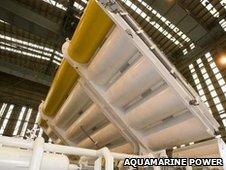New funding wave for Edinburgh energy firm
- Published

Aquamarine Power plans to deploy its new Oyster 2 device next summer
An Edinburgh-based firm which is seeking to build the world's first commercial wave farm has raised £6m in its latest round of fundraising.
Aquamarine Power said the money would facilitate the next phase of development of a new wave energy device, known as Oyster.
Oyster 1 has been undergoing sea trials at the European Marine Energy Centre (EMEC) in Orkney since last November.
Aquamarine plans to deploy its new Oyster 2 device next summer.
The company, which is seeking a total of £50m of investment, said the latest round of funding had brought the total raised so far in equity to £30m.
Aquamarine has won the rights to develop the Brough Head wave farm off the coast of Scotland, which at 200 MW could provide enough energy for about 190,000 homes.
It plans to develop up to 1,000 MW of marine energy sites by 2020 in partnership with utility SSE Renewables.
'More powerful'
Martin McAdam, chief executive of Aquamarine Power, said: "The additional fundraising enables us to progress to the next phase - the manufacture and installation of Oyster 2 - and we will announce the award of these contracts shortly."
The Oyster wave-powered generator is a hinged flap connected to the sea-bed, with each wave moving the flap to drive a hydraulic piston, delivering high-pressure water to an onshore turbine.
It is designed for use in water close to the shore, and up to 12 metres in depth.
The company said Oyster 2 would deliver 250% more power than the original device, with only a 50% increase in footprint.
"Aquamarine Power has made substantial progress over the last 12 months," Mr McAdam said.
"Our current Oyster device has performed well during sea trials surviving the harshest winter seas off the coast of Orkney and the data we have gathered from it has enabled us to design a much more powerful Oyster 2."